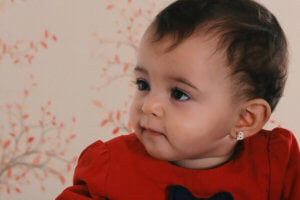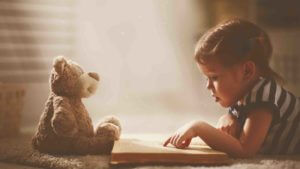The eyes are one of the most important sensory organs in humans – if not the most important. They determine to a large extent how we perceive the world. Good and clear vision is accordingly important for children in their development. Any visual impairment should therefore be examined and corrected at an early stage. The question for parents is: How and when can you recognize a visual defect in your child?
Table of contents
A Child Must First Learn To See (Sharply)
The answer is: from around the second to third year of life, parents can determine whether the child’s vision is age-appropriate. Age-appropriate because the eye is still developing at this age and therefore vision is not yet fully developed. Although a healthy child can see from birth, initially only blurred in the form of light-dark contrasts and without spatial vision.
- Also interesting:
- The best bouncy mattresses
- Recommended Harry Potter games
- The best Hot Wheels tracks and cars
During the first year of life, however, the eyes develop rapidly: on the first birthday, the child normally has about 50 percent of its visual acuity and the ability to see spatially slowly increases. Subsequently, development progresses more slowly until, at around nine years of age, the child has the same spatial vision as an adult – although the field of vision is still about 30 percent smaller. In healthy development, the eye is not considered fully mature until between about ten and twelve years of age.
Severe visual impairment can therefore be detected from around the second or third year of life. However, as a mother or father, you should keep your eyes open from the beginning and observe your child carefully. Because in addition to a relatively harmless visual impairment in various degrees, your child can of course also suffer from congenital or organic diseases of the eyes. In extreme cases, your child may be born blind – which cannot always be detected at birth.
Visual Impairments Must Be Detected As Early As Possible
As already mentioned, you should therefore observe your child from the very beginning and, if necessary, have it examined by an ophthalmologist. It is estimated that one in ten children in Germany is affected by a visual impairment. However, almost two thirds of cases remain undetected for too long. Too long, because visual impairments in children can often still be corrected easily at a young age. Sometimes it is enough to cover one of the eyes for a certain period of time and thus train the other eye, so to speak. However, if a visual defect such as strabismus is not treated until after the age of five, the chances of recovery are poor. Other visual defects such as classic nearsightedness or farsightedness should also be treated in early childhood. Otherwise, they manifest themselves into adulthood and vision often even becomes progressively worse.
How The Eyes Affect Child Development

Detecting a vision disorder in time is also important in that it can otherwise have a negative impact on a child’s development. It affects concentration, performance and motivation. Children also frequently complain of headaches, especially in the case of farsightedness. As it progresses, this limits your child’s quality of life and self-confidence. Learning is often delayed, and sometimes even school grades are poor if the defective vision remains undetected for so long.
This is not surprising, because everyday challenges such as homework are a greater burden for children with low vision than for their well-sighted peers. So to spare your child such experiences and positively influence his or her development, it is your responsibility as a mother or father to recognize and correct a visual defect in good time.
What Types Of Visual Impairment Are There?
As already mentioned, children can of course also have congenital visual impairments, extreme cases such as blindness or severe strabismus. These can often be detected at an early stage – but unfortunately not always treated adequately. So if the following risk factors are present, you should present your child to an ophthalmologist as early as six to nine months of age:
- You know that there are hereditary eye diseases in your family.
- Your child was born prematurely.
- You, your partner or your child’s siblings have a severe refractive error or suffer or suffered from strabismus.
But even if your child fortunately does not belong to this risk group, he or she should be examined by an ophthalmologist for the first time at the age of two to three years at the latest and regularly thereafter. Common refractive errors even in childhood are..
- …myopia, i.e. the child sees well up close, but blurred at a distance. This nearsightedness can be only slight and therefore does not mean any restriction for the child. But severe cases are also possible, in which even things in the vicinity are perceived only blurred. Nearsightedness is rather rare in young children, but it occurs more frequently at school age.
- …farsightedness, in which the near appears blurred, but the distance sharp. Mild farsightedness is anything but uncommon in children and often does not require treatment. In many cases, the lens of the eye compensates for the farsightedness by itself due to its elasticity in childhood. However, farsightedness should still be examined and monitored to prevent it from manifesting or worsening. A special case is also presbyopia, which makes reading glasses necessary for many people in advanced age.
A visual defect of “normal” extent is actually not too bad and can be corrected well by glasses or contact lenses – at best, the eyes even develop healthily after treatment, so that the defective vision disappears sooner or later.
How Can Defective Vision In Children Be Detected?

The problem with this, however, is that the child doesn’t just come to you and say “I see blurry” – or something like that. After all, he only knows the world from his perspective and often doesn’t even know that something is wrong. Or the child may not be able to articulate his or her problem. So it’s your job as a parent to watch for the following signs of vision problems with your son or daughter:
- The child does not start reaching for things farther away at three to four months of age.
- You observe your child squinting (even after six months), eye tremors, “tearing” of the eyes, or constant rubbing with fingers.
- It does not reach out for things out of its reach after about seven months.
- Eyes that are often watery or sticky may also indicate a vision problem.
- Your child does not seem to perceive interesting things near or far and accordingly does not try to get there.
- Another alarm signal is the rolling of the eyes without looking at anything in particular.
- Between seven and nine months, it still explores objects only with its hands and mouth – but not additionally with its eyes.
- If the pupils remain large and fixed despite exposure to light, the eyes should be examined urgently. Likewise with a yellowish or whitish lighting up.
- In young children, eye problems are sometimes indicated by frequent grimacing, no reaction to light or extreme photophobia, constant head tilting, a lack of vision, or a lack of vision in the eyes
- Constant tilting of the head, a cloudy cornea, or reaching past objects.
These signs also apply to older children, of course, but then there are usually other indications that something might be wrong with the eyes or vision:
- Your child often has reddened eyes or you observe frequent blinking or frowning.
- Your child repeatedly complains of headaches.
- You observe a conspicuous stumbling, reaching past things, poor estimation of distances or problems when playing ball.
- Balance problems or constant bumping into furniture and the like can also indicate a visual disorder.
- Your child has concentration problems and tires quickly during activities such as reading, writing or painting. He or she may also have obvious problems in such activities or when doing handicrafts, cutting out, etc.
- At school age, difficulties in reading such as reading slowly and incorrectly, slipping in the line of text, omitting words, confusing letters and numbers, or even a noticeable handwriting pattern are important clues.
- Sometimes problems with the eyes also show up in a very close distance to the book, TV, display, etc.
- Poorer school grades, social withdrawal, excessive activity, impatience and fidgetiness can also result from eye problems – but can also have other triggers.
If you observe such or similar abnormalities in your child, you should immediately consult an ophthalmologist. But even if not, regular examinations are still recommended from about two to three years of age. If there is a visual defect, the doctor will advise you on the treatment options. The most common treatment is glasses, sports glasses or contact lenses.













1 thought on “Recognizing Visual Impairment: Does Your Child Need Glasses?”